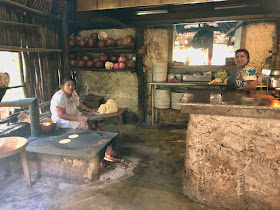 |
| Kinich – El Sabor de Izamal |
The horse drawn carriage dropped us off at the wonderful Kinich Restaurant to have a true Yucatec Maya lunch. Luckily we were early so we beat the crowds that arrive little later.
 |
| Entrance to Kinich |
The Kinich restaurant serves wonderful Yucatecan food. We were seated quickly in the beautifully open restaurant. It's definitely a tourist spot, but there's a reason for it because the food is so good.
 |
| Maya Ladies Making Tortillas |
The tortillas are freshly made by two women who patiently sit and create the wonderful tortillas that the diners will soon eat. Before food is ordered they give you complimentary hard tortillas and very spicy frijole sauce to dip it in. Habanero chiles are big in the Yucatan so the Salsas they give you is usually muy picante!
 |
| Cochinita Pibil |
 |
| Pollo Pibil |
The food itself was Great. We had the classic Cochinita Pibil and Pollo Pibil. The Cochinita was an interesting pork dish with onions buried in banana leaves over night. Pollo Pibil is a chicken dish cooked the same way over night in banana leaves. It was so good. Had Maya beer to go with it and it was perfect.
 |
| Kinich Ahua |
The name Kinich is a special name in Izamal – Kinich Ahua was the name of the Sun God for the ancient Maya in the Yucatan. In the Classic Period he was depicted as a middle aged man with an aquiline nose, large square eyes, cross-eyed with a filed incisor in the upper row of teeth. He was a very important god for Izamal. The Maya believed that Kinich Ahau would visit the city every day as a parrot at noon and take the offerings that the city gave him.
Restaurante Kinich is a wonderful place for lunch. Maya food is fantastic, and we had a great time in Izamal.
Highly recommended!
If you would like to check out more of the blog . . . Click here

























































